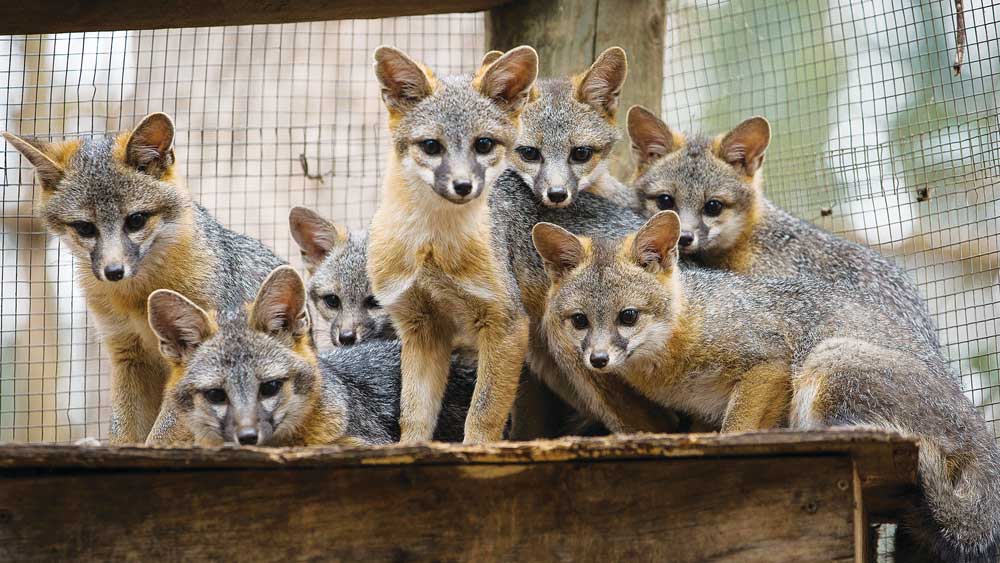
Wildlife and humans have coexisted for eons. With much open space to share it worked, until there became more of us and fewer of them. Over the past century, world population grew from 1.65 billion to 8 billion, a threshold passed last November.
Humans have expanded to nearly every part of the planet. And though the rate of growth is declining, population is expected to reach 9 billion in 2037.
As humans encroach on nature, many species become imperiled. According to a recent assessment by the World Wildlife Fund (WWF), wildlife populations tracked by scientists shrank nearly 70% between 1970 and 2018.
“When wildlife populations decline to this degree, it means dramatic changes are impacting their habitats and the food and water they rely on,” said WWF chief scientist Rebecca Shaw. “We should care deeply about the unraveling of natural systems because these same resources sustain human life.” Wildlife face many obstacles—cars, loss of habitats, wildfires and toxins to name a few. Wild creatures need our help. The innovative nonprofit Sonoma County Wildlife Rescue (SWRC) provides that, and so much more.
In the beginning…
In 1997, after 15 years in early childhood education, Doris Duncan became involved in the field of wildlife rescue and education at the urging of her 7-year-old daughter Danielle. “When I grow up, I want to be a wildlife rehabber,” Danielle said. Duncan encouraged her daughter and together they volunteered at a number of wildlife centers in Northern California. That led to Duncan becoming the first employee at Sonoma County Wildlife Rescue and, ultimately, its executive director. And Danielle McGuire, the former 7-year-old with a dream, now 33, became SCWR’s wild animal care director. In 2004, SCWR moved its headquarters from Duncan’s home to share space with the Humane Society of Sonoma County at its Highway 12 facility in Santa Rosa. As the society’s needs grew, however, it needed more room. Given a year to relocate—and with nowhere to go—the future of Sonoma County Wildlife Rescue looked hazy. In a serendipitous moment, an injured coyote provided the solution. “A coyote had been hit by a car on Petaluma’s Mecham Road,” Duncan recalls, noting the incident occurred about a month before Wildlife Rescue was expected to leave the Humane Society property. After rescuing the injured animal, Duncan says, “We nursed it back to health and were ready to release it.” The policy of the California Department of Fish & Wildlife, with whom Sonoma County is licensed, is to release animals in a suitable place in the vicinity near where they were found. Duncan released the coyote off Mecham Road where it had been rescued on a vacant plot of land owned by the county. “As I watched the coyote take off through the eucalyptus grove and down the hill, I knew that beautiful spot would make the perfect place for our rescued wildlife.”
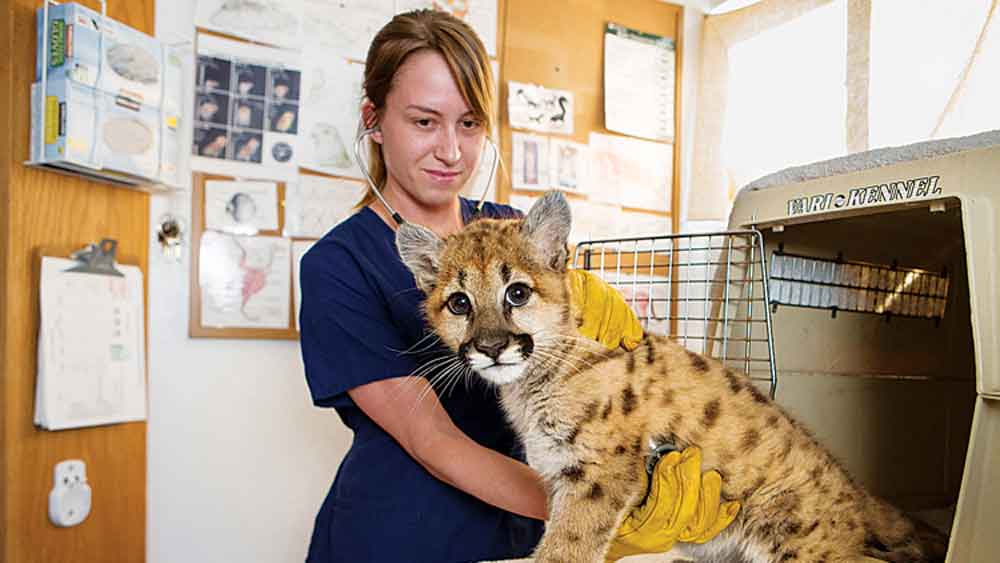
With a dedicated staff of 10 and nearly 50 volunteers, the nonprofit handles approximately 1,200 to 1,500 rescues and releases a year. The staff is cross-trained, able to fill in wherever there’s a need. SCWR also offers unique programs—the Barn Owl Maintenance Program (BOMP), A Wildlife Exclusion Service (AWES) and the Predator Exclusion and Education Program (PEEP). The organization’s annual budget is approximately $1 million, all funded through its wildlife/community support programs and donations.
Barn Owl Maintenance Program
When Wildlife Rescue lost its donated food source for rescued wildlife, the ever resourceful Duncan tracked down Santa Rosa-based rodent controller, Greg the Gopher Guy, and offered to take his trappings. On meeting up with Greg at Lynmar Estate in Sebastopol, she noticed the vineyard’s many owl boxes and got permission to look inside. Wildlife Rescue had a number of orphaned owls that needed an active nesting box. “Owls can’t count,” Duncan says. “Parents adopt orphaned chicks and raise them as their own.” Duncan also noticed that the boxes hadn’t been cleaned out. “Barn owls make good parents, but are lousy at housekeeping.” Over a breeding season, the boxes fill up with feces and pellets and the owls run out of space. Cramped owlets can push one another out and they end up on the ground where they will starve or be eaten by a predator. Similar to that moment when the injured coyote led Wildlife Rescue to its home, gophers became the impetus for the Barn Owl Maintenance Program (BOMP), the first of its kind in Sonoma County.
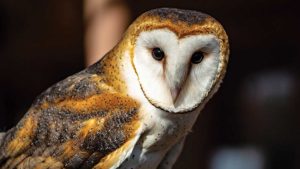
Today, Sonoma County Wildlife Rescue installs, monitors and maintains owl boxes throughout the county. Clients include 300 vineyards and other properties. The number of boxes at each site ranges from 1 to 36. Since the program’s inception, SCWR has installed 480 of its own boxes. Another 254 were purchased by clients, and monitored and maintained by SCWR.
One of their clients is Petaluma Gap’s Terra de Promissio, with 50 acres of Pinot Noir vines planted in 2002 by owners Charles and Diana Karren. Seeing the young vines being destroyed by gophers, Diana’s father Vadim, a recent immigrant from Russia, started trapping them. On reaching a count of 1,986 he decided he needed help and asked Diana to find him an owl box. “I bought one from the Petaluma Boy Scouts. My dad took it apart, made a schematic and built 15 more,” Diana says. “My son Christian, then age 12, took an interest in what his grandfather was doing. He became a spokesperson for barn owls and agricultural sustainability, speaking on the radio and manning a booth at the ag fair.” When Vadim became too old to care for the boxes and Christian left to study at UC Berkeley, SCWR took over monitoring and maintenance of Terra de Promissio’s boxes. “Many organizations talk about climate change and environmental impact but few actually follow through. Doris and her team are examples of ‘think global, act local,” Diana says. “Doris is an amazing sustainability role model. Her work makes an enormous positive contribution to our ag community, one owl box at a time.”
Based on the success of BOMP, Wildlife Rescue formed a coalition of like-minded organizations. SCWR assisted Napa Wildlife Rescue with its owl box program and in 2020 welcomed Marin’s WildCare Hungry Owl Project into the coalition. Cal Poly Humboldt is a member of the coalition’s professional support team.
Dr. Matthew Johnson, a professor of wildlife habitat ecology at Cal Poly Humboldt, initiated the Barn Owl Research Project in 2015, with the purpose of determining the effectiveness of barn-owl rodent control in vineyards. It’s the first study of its kind.
“Gophers can be destructive,” Johnson says. “They gnaw at a grape vine’s roots, and voles girdle the stalks.” A study published in Crop Protection, the official journal of the International Association for the Plant Protection Sciences, showed that vineyard yield loss from bird, gopher and vole damage is 7.2%. Throughout the spring and summer months, Johnson’s team monitors 300 boxes in Napa Valley. Infrared cameras in several of the boxes capture what the owls bring in to feed their young. The project’s findings have shown that a barn owl family of four can devour 3,400 rodents in a single year. They are perfectly adapted for their role as hunters. They have acute hearing and, with their soft feathers, fly silently through the night.
Barn owls are a safe alternative to harmful rodenticides. Rodents that consume rodenticides become slow and lethargic. They’re easy prey for raptors. Hawks, eagles and great horned owls eat them, or take them back to the nest to feed their young. And rodents killed by rodenticides can be lethal to dogs and cats, too. Tightening regulations on the use of these toxins, and the trend toward organic and agricultural sustainability, make barn owls an often-preferred alternative.
A Wildlife Exclusion Service
The nonprofit’s wildlife exclusion service offers homeowners and businesses a life-oriented and humane way to resolve nuisance wildlife problems without killing or illegal trapping. Based on years of experience working with sick, injured and orphaned wildlife, the nonprofit’s A Wildlife Exclusion Service (AWES) program is an innovative, humane way to keep critters from intruding.
Trapping and relocating wildlife in California is illegal and does not address the underlying problem. Companies that offer trapping services are legally required to euthanize the animal. Wildlife plays an important role in maintaining a balance in the ecosystem. Skunks, opossums and raccoons in particular predate on rats and mice. If relocated, their absence could allow rodents to proliferate. Exclusion allows these critters to stay in their territory and continue to do their beneficial work.
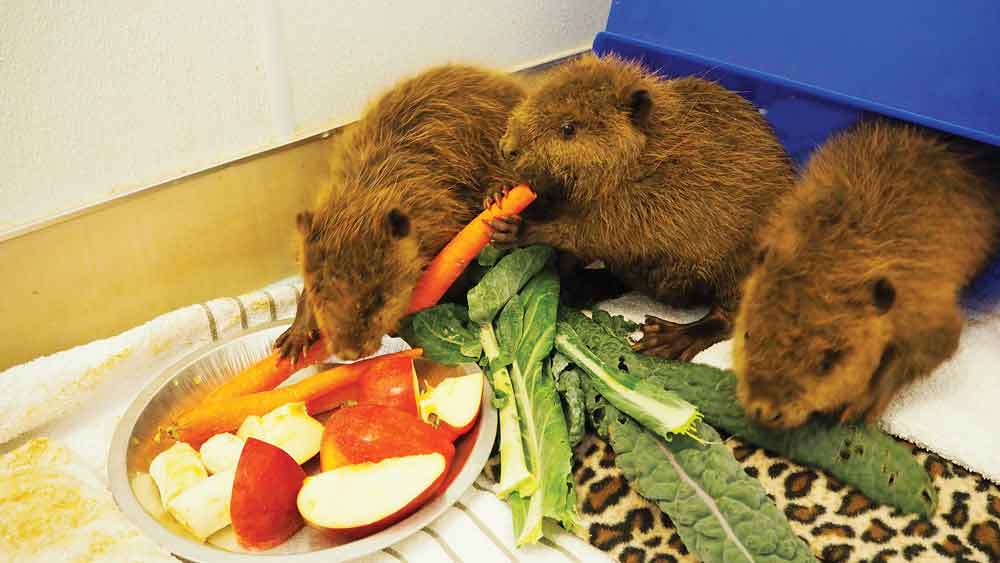
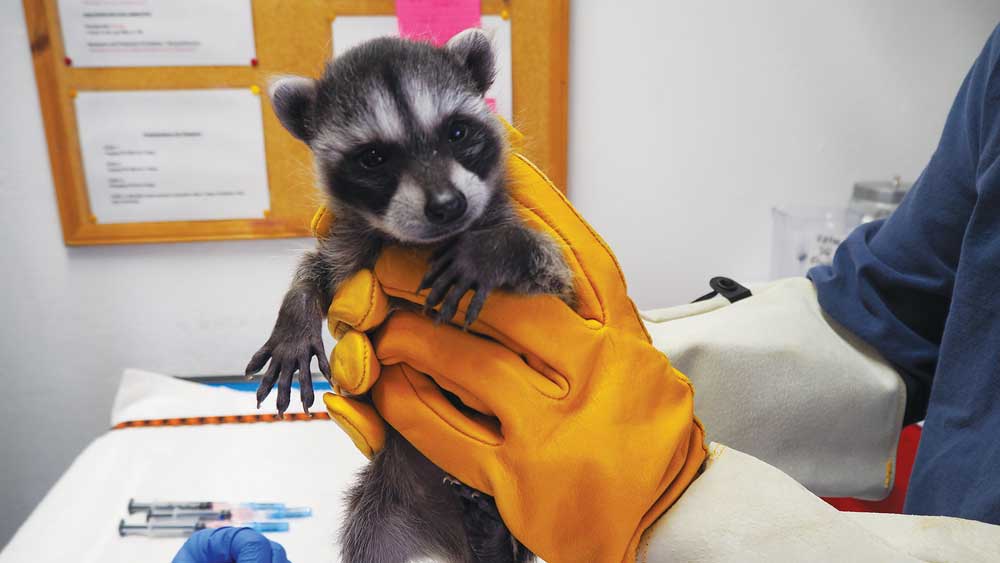
Monitoring cameras-—introduced to Wildlife Rescue by Dr. Quinton Martins of wildlife-conservation programs True Wild and Audubon Canyon’s Living with Lions Project—have become an important tool in exclusion. They allow the technician to monitor the site remotely and determine what’s happening. When they see a mother raccoon or opossum moving their babies out, they can return and seal the opening so the critters can’t return. “No two problems are the same. I enjoy the challenge,” Robinson says. “I like working with people to come up with the best solution. And I particularly enjoy sharing camera footage with a homeowner. Watching a mother with its babies or seeing an animal not normally seen, transforms the problem from nuisance or noise to a meaningful wildlife experience.”
For those interested in DIY exclusion, SCWR has a self-help section on its website, sonomawildliferescue.org. The center also sells Predator Scent, a scat- or urine-saturated den straw from resident bobcats, mountain lions and coyotes. The scent is a temporary deterrent, most successful with raccoons, skunks, foxes and even coyotes. It’s a recommended first step in exclusion work. Wildlife Rescue’s experts are available to do an on-site inspection, providing a detailed evaluation and advice on the best way to solve the problem. Proceeds from its services go toward covering SCWR’s operations.
Found an Injured Animal?
Through several permits with various state and federal agencies, SCWR is authorized to treat most wild mammals. It also treats raptors—hawks, owls and eagles—and doves, pigeons and crows. Juvenile crows go to Santa Rosa Bird Rescue. Injured waterfowl brought in are stabilized and transported to International Bird Rescue. Small birds are treated by Native Songbird Care & Conservation in Sebastopol and Santa Rosa Bird Rescue. The center does not treat turkeys or deer or mice, voles, gophers or rats. Injured animals can be brought into the center seven days a week between 9 a.m. and 5:30 p.m. The hotline (707-526-9453) should be called in advance of drop off. If unable to contain or transport an injured animal call the hotline. The caller must be able to keep eyes on the animal until wildlife personnel arrive.
Rescue, Rehab, Release
“March through September, when the babies are born, is our busy season,” McGuire says. “Things can get pretty hectic.” The rewards come in the release. “The release of an animal back into the wild is a special moment. Though I have experienced many releases, the thrill never goes away.”
A couple of those releases involved turkey vultures, and another a young mountain lion. The center’s educational ambassador, Hugo the turkey vulture, came to the center during the pandemic when another facility closed. Shortly after his arrival, the center received two 1-week-old turkey vultures unable to be reunited with their parents. Turkey vultures are highly intelligent. Under human care, they can quickly become imprinted, a phenomenon in which an infant animal bonds with its immediate protector. Wildlife Rescue placed the orphans in a rehabilitation enclosure with Hugo, so they would grow up only seeing another turkey vulture. After several months of care the orphans were released.
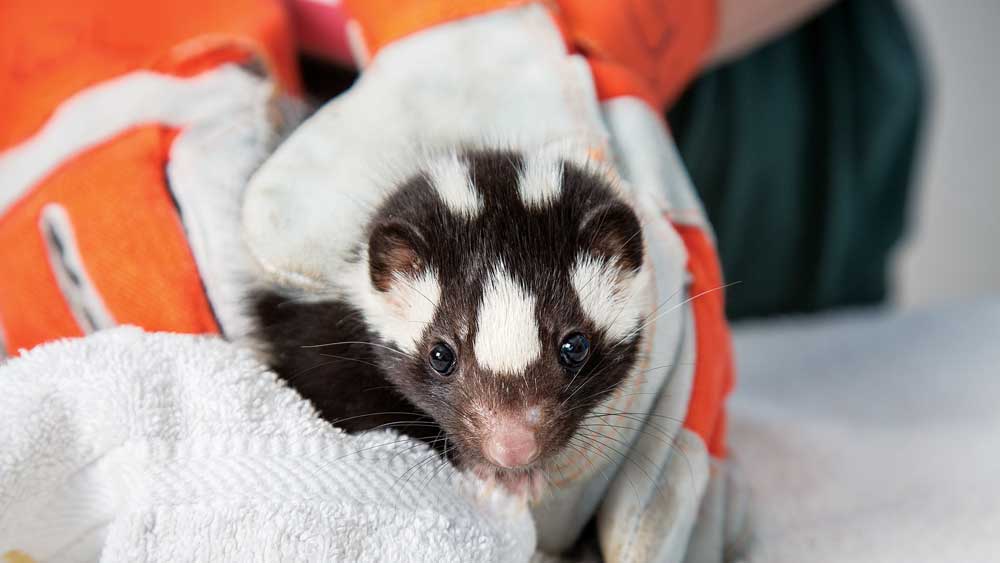
Predator Exclusion and Educational Program
The Predator Exclusion Educational Program (PEEP) began as a way to help the community understand and learn about why and how to protect their farm animals and domestic pets from wildlife predation. The program grew into an extra-curricular program for school-age children between the ages of 7 to 13. In a hands-on setting, kids learn the responsibilities of taking care of a farm, garden and farm animals and develop skills in wildlife rehabilitation and education. The animals at Sonoma County Wildlife Rescue include the Nigerian Dwarf goats, Maisie and Monty, and Hailey and Starlight, the Babydoll Southdown sheep, as well as nine chickens. Unfortunately, the after-school activity had to be suspended during the pandemic. Popular with parents and kids, Duncan hopes to restart the program once staffing is available. In the interim, parent volunteers, working with their children, take care of the small barnyard farm. Those interested in this program should contact Sonoma County Wildlife Rescue at support@scwildliferescue or 707-992-0274.
One of the parent-child pairings is 11-year-old Noa and her dad Jak Wonderly, a commercial photographer and National Geographic contributor. They’ve been volunteering at the center since Noa was 5 years old. They regularly work eight-hour Sunday shifts. “From a very young age, Noa has wanted to be a wildlife vet. I can remember her doing surgery on her stuffed animals,” Jak says with a laugh. Noa is a Jane Goodall fan. “I’ve read many of her books,” she says. Not only do Noa and Jak work with the farm animals, they also volunteer in the clinic. Though too young to handle the wild animals, Noa helps maintain the medical records, a valuable skill for a wannabe vet.
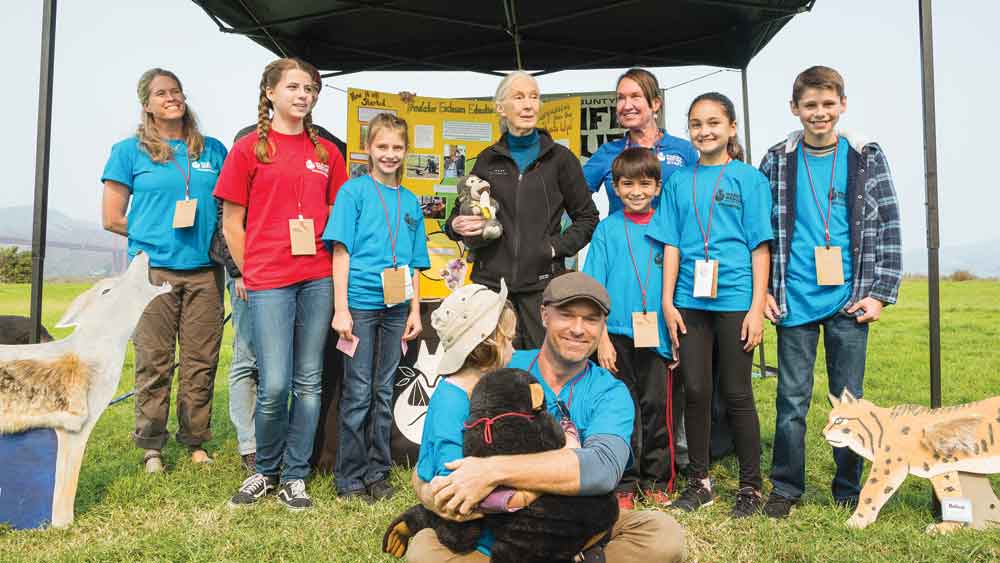
In a structure dubbed a “catio,” Samson, a black-striped cat, and Gouda, a large orange cat, roam and play outdoors, safe from predators. An elevated, wire-enclosed tunnel leads to a window at the center for access to petting by Wildlife Rescue staff. The catio serves a dual purpose. It keeps cats safe, and protects birds. In the U.S., outdoor cats kill approximately 2.4 billion birds every year. Cats are the number one, human-caused threat to bird population.
Black Bear Cubs

Tours and Education
Education is an important aspect of Sonoma County Wildlife Rescue’s mission. “In order to make an impact in helping wildlife, we must do our part in educating the community and the issues wildlife face,” Duncan says. “Through imparting knowledge of our native species, we hope to change the perception and diminish the fear many have of our wild creatures.”

Public tours of SCWR’s education center are conducted on Saturdays. Reservations are recommended. Private tours can be scheduled on request.
Sonoma County Wildlife Rescue is a happening place. By rescuing, rehabbing and releasing wild critters, the nonprofit helps maintain a balance to the ecosystem. It’s exclusion service, barn owl maintenance project and predator proofing techniques are among the first of their kind. Sonoma County Wildlife Rescue makes our corner of the world a better place for wildlife—and humans, too.
Visit scwildliferescue.org.
[Cover Photo by Jak Wonderly]
Sonoma County Wildlife Rescue
403 Mecham Road
Petaluma, CA 94952
707-992-0274
Animal Drop Off:
Daily, 9 a.m. to 5:30 p.m.
Call the hot line in advance
707-526-9453
Tours:
Saturdays only
Summer: May to September
Noon and 2 p.m.
Winter: October to April
2 p.m. only
Call 707-992-0274
to book a tour




